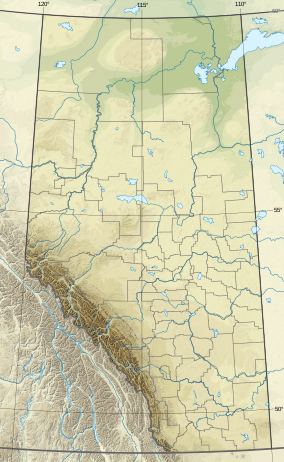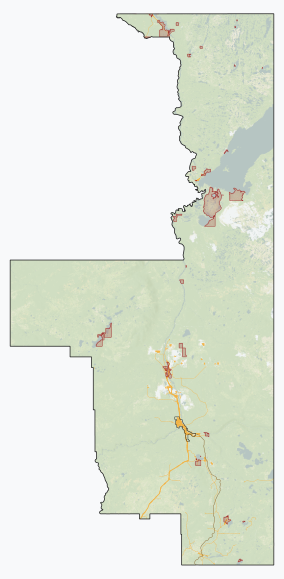Dillon River Wildland Provincial Park is a wildland provincial park in northern Alberta, Canada. It was established on 14 May 2018 and has an area of 191,545 hectares (473,320 acres).[2][3] The Government of Alberta announced the park's creation through its approval of the Lower Athabasca Regional Plan Land Use Framework in August 2012.[5]
| Dillon River Wildland Provincial Park | |
|---|---|
| Dillon River Wildland Provincial Park | |
| Location | Regional Municipality of Wood Buffalo, Alberta, Canada |
| Nearest city | Fort McMurray |
| Coordinates | 55°50′45″N 110°2′00″W / 55.84583°N 110.03333°W |
| Area | 191,545 ha (739.56 sq mi)[2] |
| Established | 14 May 2018[3] |
| Governing body | Alberta Tourism, Parks and Recreation[4] |
Location edit
The park is located in the northeast portion of the province within the southern portion of the Regional Municipality of Wood Buffalo. It is immediately west of the Saskatchewan boundary and north of the Cold Lake Air Weapons Range. It is south of Gipsy-Gordon Wildland Provincial Park.
Ecology edit
The park protects a segment of the Athabasca Plain subregion of the Boreal Forest region in the Natural Regions Framework for Alberta.[4] In the National Ecological Framework for Canada used by Environment and Climate Change Canada, the park is in the Garson Lake, Christina Plain, and Mostoos Upland ecodistricts of the Mid-Boreal Uplands ecoregion of the Central Boreal Plains ecoprovince of the Boreal Plains ecozone.[6][7] Under the OneEarth classification (previously World Wildlife Fund), the park is in the Mid-Canada Boreal Plains Forests ecoregion of the Mid-Canada Boreal Plains & Foothill Forests bioregion.[8][9]
Climate edit
The Köppen climate classification of the park is Continental, Subarctic (Dfc) characterized by long, cold, dry winters, and short, cool, summers.[10] Using the data from nearby weather stations (Kirby Lake Auto, Cowpar Lake Auto, and Christina Lake near Winefred Lake) for 1991 to 2020, the average daily temperature exceeds 10 °C (50 °F) only for June, July and August while average daily temperatures are less than 0 °C (32 °F) for November through March. At the weather stations, the long-run average precipitation from 1991 to 2020 is less than 20 mm (0.79 in) per month in the winter months of November through March. Precipitation then peaks in June and July at 90 to 100 mm (3.5 to 3.9 in) per month.[11]
Activities edit
Only hiking and random backcountry camping is permitted as there are no developed facilities in the park. There are ample opportunities for Wildlife observation. Hunting and fishing are allowed with the proper permits. Snowmobile and all-terrain vehicle riding are allowed on existing trails only. Off trail use is prohibited.[4][12]
See also edit
References edit
- ^ "Protected Area Profile for Dillon River Wildland Provincial Park from the World Database on Protected Areas". ProtectedPlanet. 2015.
- ^ a b "Plan Showing Dillon River Wildland Provincial Park" (PDF). Alberta Environment and Parks. 17 May 2018.
- ^ a b "O.C. 138/2018". Orders in Council. Government of Alberta. 14 May 2018.
- ^ a b c "Dillon River Wildland Provincial Park". Alberta Parks. 9 January 2024.
- ^ "Lower Athabasca Regional Plan 2012 - 2022" (PDF). Government of Alberta. August 2012. Archived (PDF) from the original on 25 September 2012. Retrieved 23 August 2012.
- ^ Terrestrial Ecodistricts of Canada (Map). Government of Canada. Retrieved 26 January 2024.
- ^ Ecological Land Classification, 2017 (PDF). Statistics Canada. 1 March 2018. pp. 4–5, 27. ISBN 978-0-660-24501-0. Catalogue no. 12-607-X.
- ^ Noss, Reed. "Mid-Canada Boreal Plains Forests". OneEarth.org.
- ^ "Mid-Continental Canadian forests". World Wildlife Fund. Retrieved 26 January 2024.
- ^ Atlas of Canada: Climatic Regions (PDF) (Map). Government of Canada. Archived (PDF) from the original on 15 March 2023. Retrieved 23 March 2023.
- ^ "Climate Normals for Alberta". Government of Alberta. 2020. Retrieved 26 January 2014.
- ^ "Exploring Alberta's Wildland Provincial Parks: Dillon River". Wild Albertan. Retrieved 27 January 2024.


